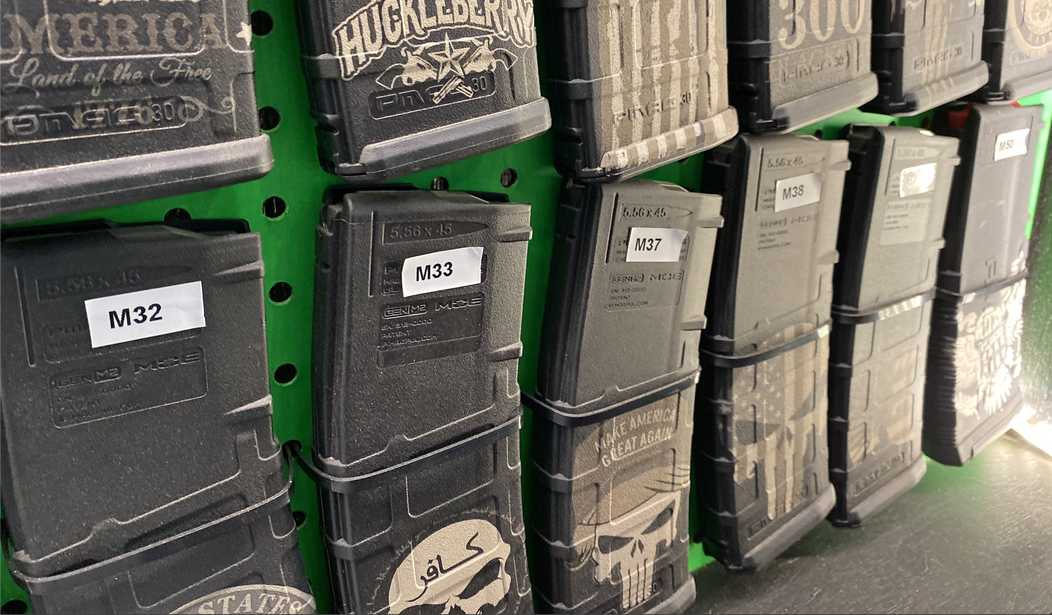For more than a decade, the District of Columbia has banned the possession of "large capacity" magazines; defined in the District as any magazine that can hold more than ten rounds. While the courts have upheld the ban in the past, a new lawsuit filed after the Supreme Court's decision in Bruen has been making its way through the legal system, and the D.C. Circuit Court of Appeals heard oral arguments on Wednesday.
Under the text, history, and tradition test spelled out by the Court in Bruen, the ban must fit within the national tradition of the right to keep and bear arms in order to stand. D.C. can no longer base its defense solely on a public safety argument, but in the absence of any longstanding or widespread statutes limiting firearm capacity in the 18th or 19th centuries, attorneys defending the ban apparently decided to make case that the law is vitally important to stopping mass shootings, or at least slowing them down.
If that's the case, however, then the law must have a similar impact on lawful citizens acting in self-defense against multiple assailants, right? Not according to D.C.'s legal eagles.
DC simultaneously argues that its magazine ban is effective because it gives people time to stop a mass shooter while they're reloading, but it's also not a burden because it only takes a few seconds for someone defending themselves to change a magazine
— Firearms Policy Coalition (@gunpolicy) February 13, 2024
It's all too common for anti-gunners to claim that their favorite laws have a major effect on violent criminals without imposing the slightest burden on lawful gun owners, but this is one of the more blatant examples of that doublespeak that I've recently run across.
D.C.'s attorneys also trotted out a trope that we've heard from prohibitionists like California Attorney General Rob Bonta; since most defensive gun uses result in fewer than ten rounds being fired, banning magazines that can hold more rounds isn't a burden on lawful self-defense.
Ashwin Phatak, the principal deputy solicitor general for the District, said studies showed that people using firearms in self-defense on average fired two or three shots. If the District raised the limit because people felt that larger magazines would make them safer from crime, “an arms race” would follow, Phatak said. “They may want a machine gun for self-defense; they may want a grenade launcher for self-defense,” Phatak said. “They have not put forward any coherent theory why they need more than eleven rounds.”
Besides the fact that there's no guarantee a particular citizen will be the victim of an "average" attack on their lives? As Judge Roger Benitez wrote in his decision tossing out California's nearly identical ban on "large capacity" magazines, these items are in common use for lawful purposes and are presumptively protected by the Second Amendment. But Benitez also took issue with the state's assertion that the "average" defensive gun use results in only 2.2 rounds being fired, noting that the "studies" they relied on are more junk than science.
Where does the 2.2 shot average originate? There is no national or state government data report on shots fired in self-defense events. There is no public government database. One would expect to see investigatory police reports as the mos tlikely source to accurately capture data on shots fired or number of shell casings found,although not every use of a gun in self-defense is reported to the police. As between the two sides, while in the better position to collect and produce such reports, the State’s Attorney General has not provided a single police report to the Court or to his own expert.
Without investigatory reports, the State’s expert turns to anecdotal statements,often from bystanders, reported in news media, and selectively studied. She indicates she conducted two studies. Based on these two studies of newspaper stories, she opines that it is statistically rare for a person to fire more than 10 rounds in self-defense and that only 2.2 shots are fired on average. Unfortunately, her opinion lacks classic indicia of reliability and her two studies cannot be reproduced and are not peer-reviewed. “Reliability and validity are two aspects of accuracy in measurement. In statistics,reliability refers to reproducibility of results." Her studies cannot be tested because she has not disclosed her data. Her studies have not been replicated. In fact, the formulaused to select 200 news stories for the Factiva study is incomprehensible.
In the end, Allen opines that an average of 2.2 shots are fired in self-defense gun scenarios and only .3% of such incidents involve more than 10 shots fired. Yet, even .3%is a lot in terms of actual times a citizen needs to fire his gun in self-defense. Using the estimate from the Centers for Disease Control mentioned earlier of 500,000 to 3,000,000 times per year nationally, and extrapolating the .3% where more than 10 shots were fired (per Allen’s report), would mean defensive gun uses of more than 10 shots happen between 1,500 and 9,000 times, every year (based on the CDC annual number of defensive gun uses cited on the website Allen cited and relied on).
While D.C. attorneys ignored Judge Benitez's findings about the average number of rounds fired, the judge did made an appearance of sorts in the courtroom on Wednesday when the District's lawyers argued in favor of keeping the ban in place while the case is being litigated.
After DC told the court that its magazine ban shouldn't be enjoined because more than 1 million were sold in California during Freedom Week, Judge Walker said "it sounds like that means large-capacity magazines are in pretty common use." https://t.co/lc4274vs97
— Firearms Policy Coalition (@gunpolicy) February 13, 2024
Indeed it does, and for that reason the D.C. Court of Appeals should reverse the district court's decision and grant an injunction halting enforcement of the magazine ban while the case proceeds to trial. Whether or not that will happen is very much an open question given the makeup of the panel, which includes an Obama-appointed judge and a Reagan appointee who concluded (pre-Bruen) that the District's ban on so-called assault weapons didn't violate the Second Amendment, but if the judges faithfully apply the Bruen test then they won't have much choice to reach the same conclusion as "Saint" Benitez did in Duncan v. Bonta; these bans are an unconstitutional infringement on the right to keep and bear arms, and the District's law must be put on hold while the case plays out in court.









Join the conversation as a VIP Member